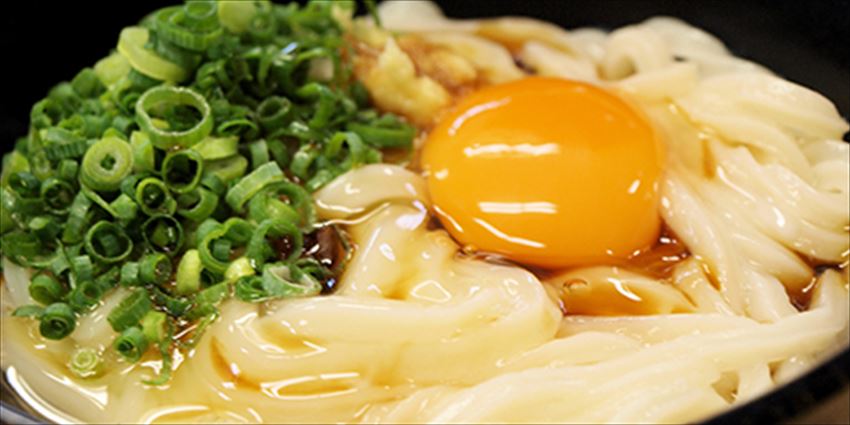If asked about the most famous food from Kagawa Prefecture, most people in Japan would reply “udon.”
This reputation is so well recognized that it is also referred to as “Udon Prefecture.”
The standard style consists of firm noodles on which soy sauce and a raw egg are poured on after the noodles are boiled.
Apparently residents of Kagawa Prefecture consume more udon than any other prefecture in Japan.
There are many shops that are open from early morning, and it is not uncommon for people to have udon for breakfast.
Sanuki udon are characterized by very firm and chewy noodles, a texture that makes them go down smoothly, and a wheat flavor that comes out the more the noodles are chewed.
These noodles are popular not only among tourists, but are also considered to be a widely popular soul food among local residents.


On the other hand, if one mentions udon in relation to Fukuoka Prefecture, there are surprisingly few people outside of Fukuoka Prefecture that are aware of the fact that udon is an extremely popular food there that is eaten on a regular basis.
Most people generally think of ramen in connection to Fukuoka or Hakata and the idea that people from these areas also often eat udon really hasn’t spread.
However, local people actually eat udon much more frequently than ramen.
There are always long lines at udon shops in business districts during lunchtime.
Hakata udon is characterized by noodles that are surprisingly soft compared to Sanuki udon.
Many people that eat it for the first time are surprised.
One could exaggerate and say that eating it makes you feel like you are biting through your lips.
This is because Hakata udon is constantly boiled in a large pot, and when you place an order the noodles are removed from this pot and piping-hot soup that contains a broth strongly-flavored with bonito and kelp is poured in with the noodles.

Source: Fukuoka City

Source: Fukuoka City
Which prefecture did udon actually originate from?
First, looking back at the history of udon in Kagawa Prefecture, there was mention of udon shops in Sanuki (modern Kagawa Prefecture) on the “Konpira Saireizu Byobu” (Konpira Festival Diagram Folding Screen) from the early 18th century.
The folding screen seems to suggest that there were three udon shops among the approximately 200 buildings contained in Konpira’s temple town at that time.
While there are a number of theories concerning where Hakata udon originated from, one theory involves a monument in the Jotenji temple found in Hakata Ward called the “Udon Soba Hasshonochi” (Point of Origin for Udon and Soba).
It is said that the characteristic soft texture of Hakata udon today is due to the fact that shops would keep noodles boiling so that soup could be added to it quickly, which would allow people to eat quickly in between work as was required by the busy merchants of Hakata.
In fact, there were many food stall style udon shops in Hakata during the Meiji period.

Source: Fukuoka City
Lots of green onion and raw egg are essential for Sanuki udon.
In addition, you can select as many ingredients as you like including tempura and put in additional orders afterwards.
Perhaps one of the reasons this type of udon is popular is that you can make your own style of udon according to your preferences.
With Hakata udon, at most shops you can put in as much green onion as you want. Another defining characteristic is that in addition to ichimi (ground red chili pepper) and shichimi (Japanese spice mixture containing seven ingredients), yuzukosho (yuzu pepper seasoning) is always available on the table as a seasoning.
The most popular type of tempura is burdock, and there is also the very popular custom of eating udon together with kashiwa gohan, which is rice that is cooked together with chicken and burdock.






Comments